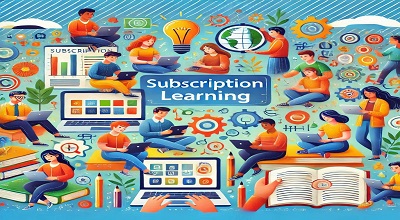Subscription-Based Learning
The education sector has witnessed a digital transformation over the past decade, accelerated by the rise of subscription-based learning platforms. These platforms are redefining how individuals learn, offering unprecedented access to knowledge and skill development. From students seeking additional support to professionals looking to upskill, subscription-based platforms have become an essential resource. This article explores the latest trends, benefits, and challenges of subscription-based learning platforms while spotlighting the key players in the field.
Understanding Subscription-Based Learning Platforms
Subscription-based learning platforms operate on a model where users pay a recurring fee, typically monthly or annually, to access a library of educational content. These platforms cater to diverse learning needs, including academic tutoring, professional certifications, hobby-based learning, and personal development.
Key Features
- Diverse Content Library: A wide range of courses, tutorials, and resources.
- Flexible Learning: Learners can access materials anytime and anywhere.
- Adaptive Learning Technology: Personalized learning paths tailored to individual needs.
- Interactive Tools: Quizzes, projects, and forums enhance engagement.
- Certifications: Many platforms offer recognized credentials upon course completion.
Latest Trends in Subscription-Based Learning Platforms
1. AI-Driven Personalization
Artificial Intelligence (AI) is a game-changer in online learning. Platforms leverage AI to assess a learner’s strengths and weaknesses, recommending tailored content. AI-driven chatbots also provide real-time support, improving user experience.
2. Gamification
Gamification elements such as badges, leaderboards, and rewards make learning engaging. Platforms like Duolingo and Khan Academy incorporate these features to motivate learners.
3. Microlearning
Bite-sized lessons are increasingly popular, catering to busy professionals. Platforms like LinkedIn Learning and Coursera offer short, focused courses for quick skill acquisition.
4. Subscription Bundles
Many platforms now partner with organizations to offer bundled subscriptions. For instance, companies can subscribe to platforms for employee training, providing employees unlimited access to learning resources.
5. Virtual Reality (VR) and Augmented Reality (AR)
Immersive learning experiences are on the rise. Platforms like Labster use VR/AR to simulate real-world scenarios, particularly in fields like healthcare and engineering.
6. Focus on Soft Skills
Demand for soft skills training has surged. Platforms now emphasize leadership, communication, and emotional intelligence courses alongside technical skills.
Advantages of Subscription-Based Learning Platforms
1. Cost-Effectiveness
A single subscription provides access to a vast repository of content, often cheaper than traditional learning methods.
2. Global Accessibility
Learners from any location can access world-class educators and resources, breaking geographical barriers.
3. Continuous Learning
With a subscription, learners can explore multiple subjects and continuously upgrade their skills without needing to enroll in separate courses.
4. Community and Networking
Many platforms feature forums and live sessions, allowing learners to connect with peers and industry experts globally.
5. Self-Paced Learning
Subscriptions enable users to learn at their own pace, accommodating individual schedules and learning speeds.
Challenges and Limitations
1. Subscription Fatigue
With numerous platforms available, users may feel overwhelmed and financially strained managing multiple subscriptions.
2. Content Overload
A vast library can lead to decision paralysis, where users struggle to choose relevant courses.
3. Digital Divide
Not everyone has access to stable internet or digital devices, limiting the reach of online platforms.
4. Quality Assurance
The absence of standardized regulations can result in variable course quality across platforms.
5. Lack of Practical Application
Some courses lack hands-on elements, making it difficult for learners to apply theoretical knowledge in real-world contexts.
Top Subscription-Based Learning Platforms in 2024
1. Coursera
Offers courses from leading universities and institutions, including certifications and degree programs.
2. LinkedIn Learning
Focuses on professional development with courses in business, technology, and creative fields.
3. Skillshare
Caters to creatives with tutorials in design, photography, and writing.
4. Udemy
Boasts a vast library of courses across disciplines, often at affordable rates.
5. Duolingo
Specializes in language learning with interactive, gamified lessons.
6. MasterClass
Features celebrity instructors teaching skills ranging from filmmaking to cooking.
7. Pluralsight
Focuses on technology and IT-related skills, offering paths for certification.
The Future of Subscription-Based Learning Platforms
1. Integration with Corporate Training
Companies increasingly use platforms for workforce development, tailoring subscriptions to organizational needs.
2. Blockchain for Certification
Blockchain technology ensures secure and verifiable digital credentials, enhancing trust in certifications.
3. Increased Accessibility
Efforts to bridge the digital divide include offline access and subsidized plans for underserved communities.
4. Lifelong Learning Models
Platforms are aligning their content with the concept of lifelong learning, supporting users through various career stages.
5. Collaboration with Governments
Governments partnering with platforms to enhance education systems and workforce readiness will further bolster the industry.
FAQs
1. What is a subscription-based learning platform?
A subscription-based learning platform allows users to access a library of educational content for a recurring fee, providing resources for skill development, academic learning, and personal growth.
2. How do these platforms personalize learning experiences?
They use AI algorithms to assess user preferences, learning pace, and strengths, creating tailored content recommendations and adaptive learning paths.
3. Are certificates from these platforms recognized?
While many platforms offer recognized certifications, the value often depends on the platform’s reputation and partnerships with institutions or industry bodies.
4. Can I cancel my subscription anytime?
Most platforms offer flexible cancellation policies, allowing users to unsubscribe at their convenience.
5. How do I choose the right platform for my needs?
Identify your goals, compare features, read reviews, and consider trial periods to determine the best fit.
6. Are subscription-based platforms suitable for children?
Yes, platforms like Khan Academy and ABCmouse cater specifically to young learners with age-appropriate content.
7. Do these platforms offer offline access?
Some platforms provide downloadable resources or mobile apps for offline learning, ensuring flexibility in low-internet areas.
Conclusion
Subscription-based learning platforms have revolutionized education by making it more accessible, affordable, and flexible. They continue to evolve, integrating advanced technologies and diverse content to cater to varied learning needs. As the industry grows, it holds immense potential to empower individuals and organizations alike, fostering a culture of continuous learning in a rapidly changing world.
